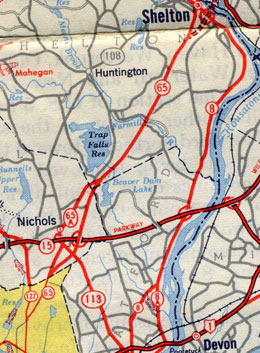Drive the original Route 8
To drive the original Route 8 (northbound), start at the corner of US 1 and Route 113 in Stratford. From its inception in 1922 or 1923 until its rerouting in 1951, Route 8 started here, not in Bridgeport.
Apologies: some exit numbers may be out of date due to the switch from sequential to mileage-based.
Drive north on Route 113 until it ends shortly at Route 110. To the left, the old Route 8 continued; to the right, Route 8A reconnected with US 1. Turn left (north) onto Route 110.
For the next few miles, you will follow the west bank of the Housatonic River. The primary roadgeek point of interest is the interchange with Route 15, near the north end of the Merritt Parkway. The four-ramp interchange built in 1940 was upgraded to seven ramps in 1958 for increased capacity, then revised to five ramps again in 1998 for increased safety.
As you enter downtown Shelton, you'll pass under the existing Route 8 freeway, and soon encounter Bridgeport Avenue to the left. This road, now "secret" route SR 714, was the post-1952 routing of Route 8, until the freeway opened in the 1980s. At Bridge Street (appropriately), turn right and cross the Housatonic River. The Commodore Hull Bridge on modern Route 8 opened in 1951.
Once in Derby, turn right (east) on Route 34, then left again on Elizabeth Street. After proceeding north for about a mile, turn left (north) on Seymour Avenue. As you cross into Ansonia, the street becomes Wakelee Avenue, and merges with Route 334. Just after the interchange with Route 8, turn right on Lower Derby Road, which enters Seymour.
Lower Derby Road does end shortly afterward; the original road is not accessible at this point. Instead, use the entrance ramp to Route 8 north (exit 20) and get off at the next exit (Derby Avenue). You'll eventually reach Route 313 and Route 67. Turn right on Route 67, and left on North Main Street. In Beacon Falls, this road turns into South Main Street, then Old Turnpike. (I'm not absolutely certain of the original route between routes 67 and 42, but this one is the most likely).
Turn right on Route 42 and follow it toward Beacon Falls center. When Route 42 turns east, keep going north, on Main Street. This four-lane road was widened in 1942, and was the last section of Route 8 to be upgraded to a freeway, decades later. You'll need to use the next entrance to Route 8 north, since Main Street ends shortly afterward. The original roadbed is gone, replaced by the freeway.
The old Route 8 through Waterbury includes South Main St, West Main St, and Thomaston Avenue. You'll follow the east bank of the Naugatuck River while the modern Route 8 follows the west. Thomaston Road in Waterbury becomes Waterbury Road in Thomaston; Connecticut towns are often reciprocally polite that way.
As you enter Thomaston on Waterbury Road (SR 848), things start to get complicated. At an interchange with modern Route 8, the road becomes Route 254 and Main St. Continue ahead, but when 254 branches to the left, stay on Main St, which is now SR 807.
About 5 blocks later, Route 222 appears; take 222 north (North Main St) until you pass under Route 8 again. Shortly after that, Route 222 will fork right. Continue straight on Main St.
Main Street will dead end after that; park your car and continue walking in that direction, and you'll reach the Thomaston Dam; cross that and keep walking, and you'll reach Castle Bridge, which was closed some time back. Now you'll have to retrace your steps back to the car.
Drive back to Route 222 and get on Route 8 north. At the next exit (41), get off and turn right, crossing into Harwinton. When you reach Valley Road, turn right again; now you're going south on old Route 8. The road will end, and you can park, keep walking, and reach the other side of Castle Bridge. Return to your car.
Valley Road dead ends on its north side as well, at the village of Campville. If you walk north from there, you will eventually reach modern Route 8, which buried some of the older highway. The original Route 8 crossed the Naugatuck River back into Litchfield slightly north of Route 118.
Once you backtrack to exit 41, take Route 8 north to exit 42 and turn west on Route 118. Turn north on Thomaston Road (SR 800) and it's a fairly easy trip through Torrington to US 44 at Winsted on the same road. There, the freeway ends, and Route 8 continues as a two-lane road into Massachusetts.
In the Colebrook River Reservoir recreational site, there's a 7-mile segment of old Route 8, accessible only when water levels are low.



 This 1949 map scan shows the historic alignments of routes 8 and 65 south of Shelton and Derby.
This 1949 map scan shows the historic alignments of routes 8 and 65 south of Shelton and Derby.